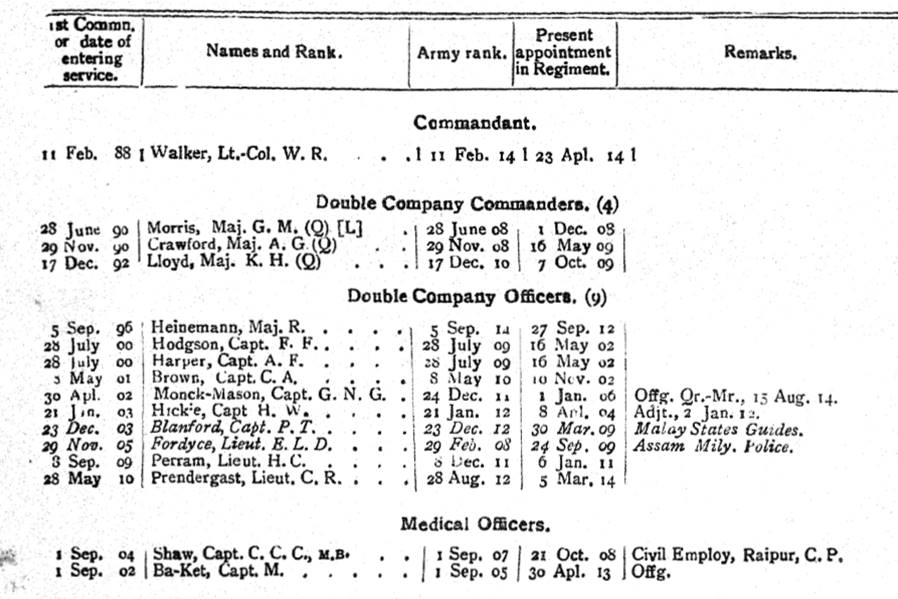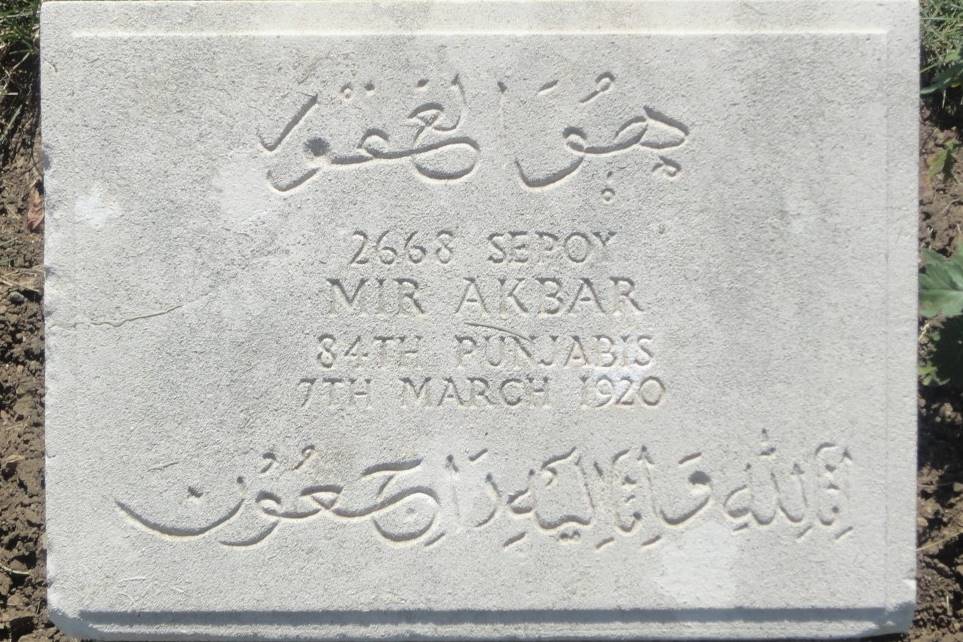This article on the 84th Punjabis aims to help you to either research the Regiment or a soldier who served with it during the First World War. I’ve also written a series of guides to help you research soldiers who served in the Indian Army during the war:
The 84th Punjabis in the First World War
Lineage: Raised by Captain M. Macdonald at Vellore in 1794 as the 34th Battalion of Madras Native Infantry. It became the 2nd Battalion, 12th Regiment of Madras Native Infantry in 1797, the 24th Regiment of Madras Native Infantry in 1824, the 24th Regiment of Madras Infantry in 1885, the 24th Madras Infantry in 1901 and the 84th Punjabis in 1903. In 1922, became the 10th Battalion 1st Punjab Regiment which was the Regiment’s training battalion.
Composition in 1914: 4 Companies of Punjabi Muslims, 2 Companies of Sikhs and 2 Companies of Rajputs from Western Rajputana and the Eastern Punjab. 1919: 2 Companies of Punjabi Muslim, 1 Company of Sikhs and 1 Company of Rajputs from Western Rajputana and the Eastern Punjab.
Location in July 1914: The 84th Punjabis was stationed at Rawalpindi (Punjab, Pakistan) having arrived from Samana (Punjab, India) on 12 March 1910.
The 84th Punjabis was stationed at Rawalpindi, an important cantonment in British India, when the First World War broke out in August 1914. The Regiment was inspected by Brigadier-General Herbert Vaughan Cox, Commanding Rawalpindi Brigade earlier in the year who reported:
The battalion is up to the average at drill and handling arms. There is a noticeable improvement at manoeuvre, less hesitation and more alertness, but a great deal remains to be done. The weak points now are some of the Indian officers and a good many of the non-commissioned officers.
The men are active and willing and well up to the average of their classes in other corps. It is the subordinate leaders who are wanting in activity, initiative and knowledge. Fire discipline is improved, but here the section leaders are again the weak point and want a great deal of careful instruction. Scouts are well trained, active and did well on manoeuvres. Machine gun sections satisfactory. The regiment did much better at manoeuvres this year, particularly at hill warfare.
Confidential review reports on Indian Army units for 1913-1914: IOR/L/MIL/7/17023.
The extract below was taken from the October 1914 Indian Army List and recorded the British officers serving with the Regiment.

In April 1917, the 84th Punjabis left India and arrived at Basra, Mesopotamia, now Iraq, to take part in the Mesopotamia Campaign. The 84th Punjabis initially served on the Euphrates Defences and Lines of Communication at Nasiriyah between April and August 1917. I have transcribed the entire war diary for this period below. The 84th Punjabis subsequently joined the 52nd Indian Brigade, 17th Indian Division and there is a war diary covering the period between September 1917 and September 1918.
After remaining at Baghdad or in its vicinity for the latter months of 1917, the 84th Punjabis joined the Hillah Column on 15 December 1917. The Regiment spent the early weeks of 1918 at Kufa, 10 km (6 miles) northeast of Najaf. The Regiment moved frequently after February 1918 before it arrived at Tel Muhaijir, north of Samarra on 18 April 1918. Here the Regiment remained for a month before it moved a short distance to Al Ajik, Samarra where it stayed until mid-August. The 84th Punjabis then moved to Jibin Wadi, near Tikrit and then to the city itself where it arrived on 6 September 1918. The Regiment remained at Tikrit until 19 September before moving to Baghdad and then frequently over the next week before reaching Makina, near Basra on 25 September.
The 84th Punjabis did not remain in the Middle East for long after the war as the Regiment moved to Salonika, now Thessaloniki, Greece in November 1918 and subsequently the Caucuses. During 1919, the Regiment moved to Turkey and served in the Army of Occupation. The 84th Punjabis returned to India in late 1920 and in the July 1921 Indian Army List the Regiment was recorded as being stationed at Jhelum (Punjab, Pakistan). In 1922, the 84th Punjabis became the 10th Battalion 1st Punjab Regiment which was the Regiment’s training battalion.
Below is the headstone of Sepoy Mir Akbar, 84th Punjabis who was the son of Sher Dil Khan, of Kehu, Abbottabad, Hazara, in present-day Pakistan. Mir Akbar is buried in the Haidar Pasha Cemetery, on the Asiatic side of Istanbul, Turkey. The cemetery also contains the graves of thousands of British soldiers who died of their wounds or disease at Scutari which was located nearby.
War Diaries of the 84th Punjabis
There are two war diaries for the 84th Punjabis and both have been digitized and are available to download for a small fee from the National Archives’ website. Click on the blue links below to be taken to the correct page. I have transcribed the first war diary in its entirety below.
- Date: 15 April – 31 August 1917
- Euphrates Defence and Communications, Nasiriyah, Mesopotamia
- Reference: WO 95/ 5031/10
- Notes: A very poor war diary for the 84th Punjabis. I have transcribed the entire war diary below.
- Date: 01 September 1917 – 29 September 1918
- 52nd Indian Infantry Brigade, 17th Indian Division
- Reference: WO 95/ 5213/6
- Notes: A very poor war diary until December 1917 when the entries start to become more frequent and detailed. There is a roll of British officers serving with the 84th Punjabis in May, July and August 1918. Apart from the rolls of British officers at the end of these three months, there are no appendices.
Further Sources for the 84th Punjabis
A good resource for the 84th Punjabis and the British officers who served with it are its confidential reports held at the British Library: Confidential Reports on Regiments etc. These regimental confidential reports contain typed copies of the British officers’ confidential reports which were duplicated in their service records. As the majority of these service records are now lost, these confidential reports are vital if you are researching a British officer and I have a complete set. For information concerning the British and Indian officers who served with the 84th Punjabis, the Indian Army List can be consulted.
Extracts from War Diaries of the 84th Punjabis
15 April – 31 August 1917, Mesopotamia, WO 95/ 5031/10
15 April 1917 – Arrival in Basrah of Regimental HQ, B and C Companies and Band, awaiting arrival of remainder of regiment.
26 April 1917- Basrah – Arrival of A and D Companies.
2 May 1917 – Nasiriyeh – Regiment entrained at Basrah on 1 May 1917 and arrived at Nasiriyah on 2 May 1917.
12 May 1917 – Nasiriyeh – An escort of 44 men under 2nd Lieutenant A.D. Cassell left in bellums for Chabaish to [?]
16 May 1917 – Nasiriyeh – Regiment detailed to Nasiriyah Moveable Column and attended Moveable Column Parade for inspection by General Officer Commanding Euphrates Front.
18 June 1917 – Nasiriyeh – Moveable Column route march.
18 July 1917 – Nasiriyeh – Regiment supported political action by occupying Hammer Hill.
16 August 1917 – Nasiriyeh – Moveable Column route march.
17 August 1917 – Nasiriyeh – A Russian Tatar, No. 24975, Fakruddin, is attached to the regiment, pending repatriation.
27 August 1917 – Nasiriyeh – Regiment left Nasiriyah for Baghdad.
28 August 1917 – Basrah – Arrived at Basrah. Regimental Headquarters, B and C Companies and 1/2 D Company left Basrah for Baghdad embarking at 10 PM on P.55.
31 August 1917 – Basrah – Remainder of regiment embarked on P61 for Baghdad to join Headquarters.

